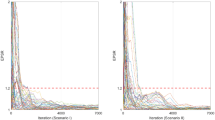Abstract
We establish an identity that relates B-spline functions to linear combinations of gamma density functions. Utilizing this connection, we illustrate that, for exponentially distributed lifetimes, the distribution of the MLE in various hybrid censoring schemes can be expressed in terms of gamma density functions with simple weights. As an example, representations for the density functions in the case of Type-I sequential, Type-II progressive hybrid, generalized Type-I progressive hybrid, and generalized Type-II progressive hybrid censoring schemes are presented. It turns out that the representations arising from the spacings’ based approach introduced in Cramer and Balakrishnan (Stat Methodol 10:128–150, 2013) are more compact than those available in the literature so far.


Similar content being viewed by others
References
Balakrishnan N, Aggarwala R (2000) Progressive censoring: theory, methods, and applications. Birkhäuser, Boston
Balakrishnan N, Rasouli A, Farsipour N (2008) Exact likelihood inference based on an unified hybrid censored sample from the exponential distribution. J Stat Comput Simul 78:475–488
Balakrishnan N, Cramer E (2014) The art of progressive censoring. Applications to reliability and quality. Birkhäuser, New York
Balakrishnan N, Kundu D (2013) Hybrid censoring: models, inferential results and applications (with discussions). Comput Stat Data Anal 57:166–209
Balakrishnan N, Kundu D, Ng HKT, Kannan N (2007) Point and interval estimation for a simple step-stress model with Type-II censoring. J Qual Technol 39:35–47
Balakrishnan N, Xie Q, Kundu D (2009) Exact inference for a simple step-stress model from the exponential distribution under time constraint. Ann Inst Stat Math 61:251–274
Bartholomew DJ (1963) The sampling distribution of an estimate arising in life testing. Technometrics 5:361–374
Burkschat M, Cramer E, Górny J (2016) Type-I censored sequential \(k\)-out-of-\(n\) systems. Appl Math Model 40:8156–8174
Burkschat M, Lenz B (2009) Marginal distributions of the counting process associated with generalized order statistics. Commun Stat Theory Methods 38:2089–2106
Chan SH, Ng HKT, Su F (2015) Exact likelihood inference for the two-parameter exponential distribution under Type-II progressively hybrid censoring. Metrika 78:747–770
Chandrasekar B, Childs A, Balakrishnan N (2004) Exact likelihood inference for the exponential distribution under generalized Type-I and Type-II hybrid censoring. Nav Res Logist 51:994–1004
Chen S-M, Bhattacharyya GK (1988) Exact confidence bounds for an exponential parameter under hybrid censoring. Commun Stat Theory Methods 16:2429–2442
Childs A, Chandrasekar B, Balakrishnan N, Kundu D (2003) Exact likelihood inference based on Type-I and Type-II hybrid censored samples from the exponential distribution. Ann Inst Stat Math 55:319–330
Childs A, Chandrasekar B, Balakrishnan N (2008) Exact likelihood inference for an exponential parameter under progressive hybrid censoring schemes. In: Vonta F, Nikulin M, Limnios N, Huber-Carol C (eds) Statistical models and methods for biomedical and technical systems. Birkhäuser, Boston, pp 323–334
Childs A, Balakrishnan N, Chandrasekar B (2012) Exact distribution of the MLEs of the parameters and of the quantiles of two-parameter exponential distribution under hybrid censoring. Statistics 46:441–458
Cho Y, Sun H, Lee K (2015) Exact likelihood inference for an exponential parameter under generalized progressive hybrid censoring scheme. Stat Methodol 23:18–34
Cramer E (2016) Sequential order statistics. Statistics Reference Online, Wiley StatsRef
Cramer E, Kamps U (2001a) Estimation with sequential order statistics from exponential distributions. Ann Inst Stat Math 53:307–324
Cramer E, Kamps U (2001b) In: Balakrishnan N, Rao CR (Eds.) Sequential \(k\)-out-of-\(n\) systems, in Handbook of statistics: advances in reliability, Vol. 20. chap. 12, Elsevier, Amsterdam pp 301–372
Cramer E, Balakrishnan N (2013) On some exact distributional results based on Type-I progressively hybrid censored data from exponential distributions. Stat Methodol 10:128–150
Cramer E, Burkschat M, Górny J (2016) On the exact distribution of the MLEs based on Type-II progressively hybrid censored data from exponential distributions. J Stat Comput Simul 86:2036–2052
de Boor C (2001) A Practical Guide to Splines. Springer, New York, revised edition
Epstein B (1954) Truncated life tests in the exponential case. Ann Math Stat 25:555–564
Ganguly A, Mitra S, Samanta D, Kundu D (2012) Exact inference for the two-parameter exponential distribution under Type-II hybrid censoring. J Stat Plan Inference 142:613–625
Górny J, Cramer E (2016) Exact likelihood inference for exponential distributions under generalized progressive hybrid censoring schemes. Stat Methodol 29:70–94
Gurler S (2012) On residual lifetimes in sequential \((n-k+1)\)-out-of-\(n\) systems. Stat Pap 53:23–31
Ismail AA (2016) Statistical inference for a step-stress partially-accelerated life test model with an adaptive Type-I progressively hybrid censored data from Weibull distribution. Stat Pap 57:271–301
Kamps U (1995) A concept of generalized order statistics. J Stat Plan Inference 48:1–23
Kateri M, Kamps U (2015) Inference in step-stress models based on failure rates. Stat Pap 56:639–660
Lee K, Sun H, Cho Y (2016) Exact likelihood inference of the exponential parameter under generalized Type II progressive hybrid censoring. J Korean Stat Soc 45:123–136
Lin CT, Huang Y-L (2012) On progressive hybrid censored exponential distribution. J Stat Comput Simul 82:689–709
Schumaker L (2007) Spline functions: basic theory, 3rd edn. Cambridge University Press, Cambridge
Soltani AR, Roozegar R (2012) On distribution of randomly ordered uniform incremental weighted averages: divided differences approach. Stat Probab Lett 82:1012–1020
Author information
Authors and Affiliations
Corresponding author
Rights and permissions
About this article
Cite this article
Górny, J., Cramer, E. From B-spline representations to gamma representations in hybrid censoring. Stat Papers 60, 1119–1135 (2019). https://doi.org/10.1007/s00362-016-0866-4
Received:
Revised:
Published:
Issue Date:
DOI: https://doi.org/10.1007/s00362-016-0866-4
Keywords
- Hybrid censoring
- Progressive censoring
- Type-I censored sequential k-out-of-n systems
- Type-I progressive hybrid censoring
- Adaptive Type-I progressive hybrid censoring
- Type-II progressive hybrid censoring
- Generalized Type-I progressive hybrid censoring
- Generalized Type-II progressive hybrid censoring
- B-spline
- Divided differences
- Exponential distribution
- Gamma distribution
- Simple step-stress model




